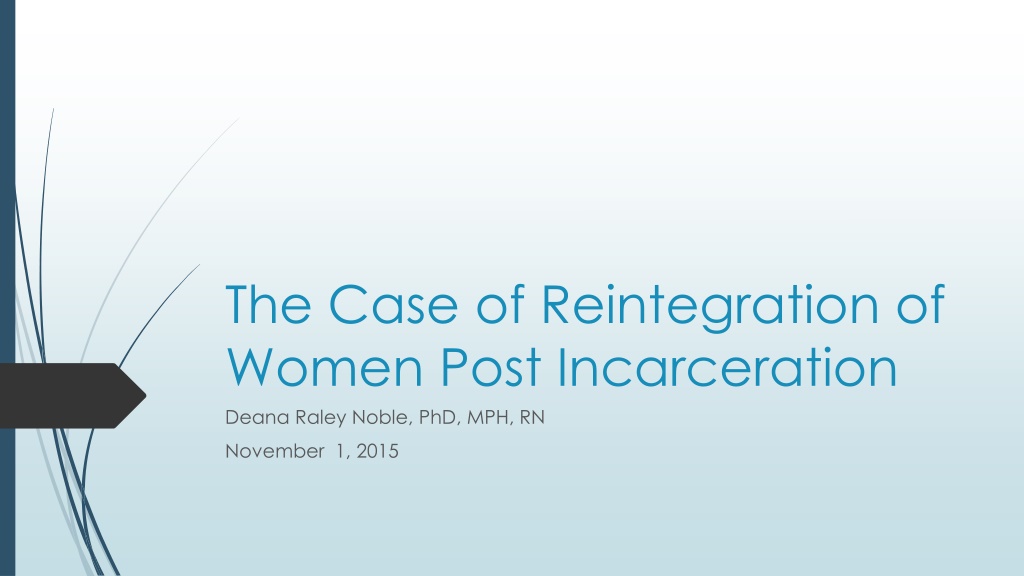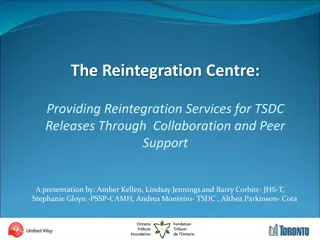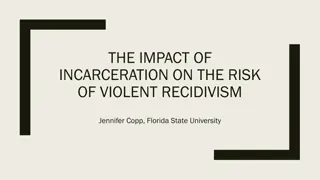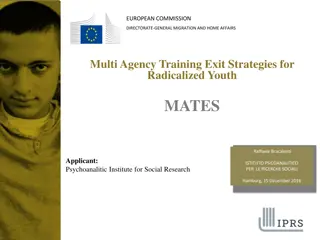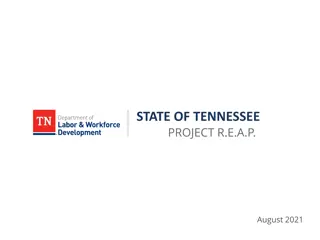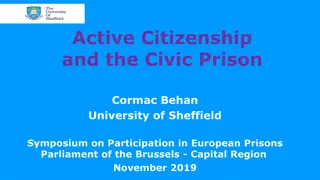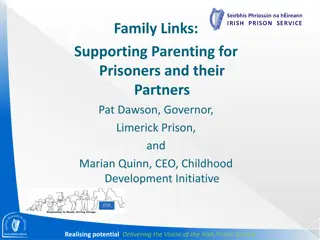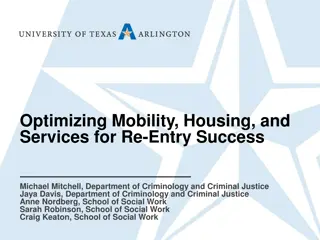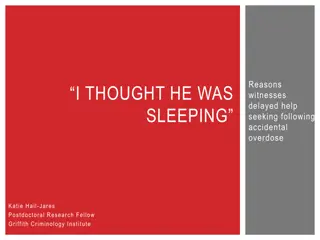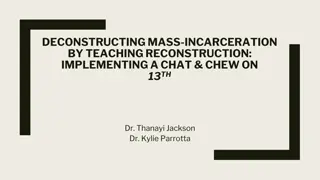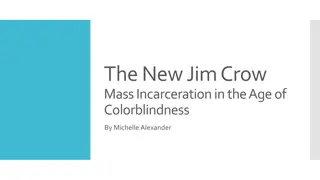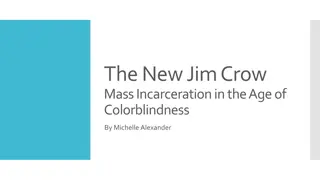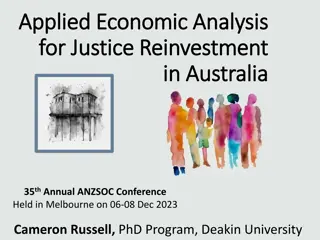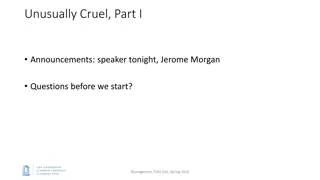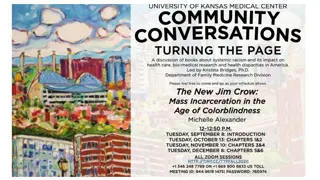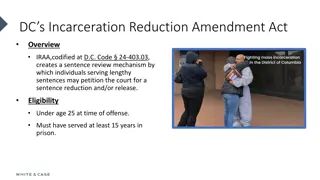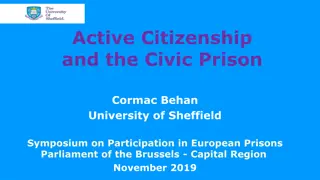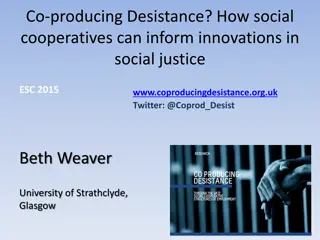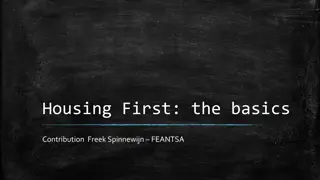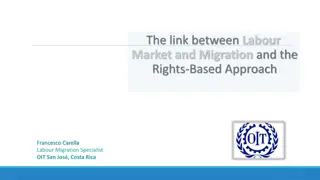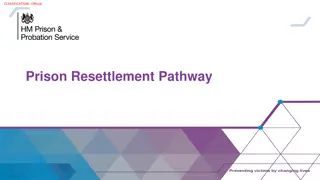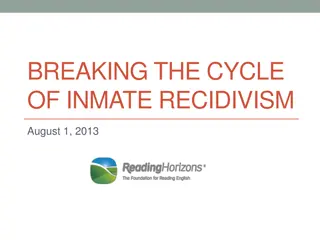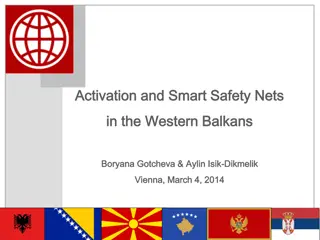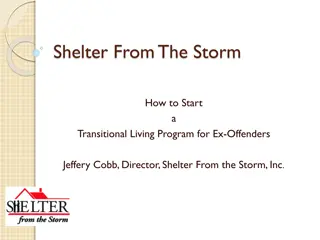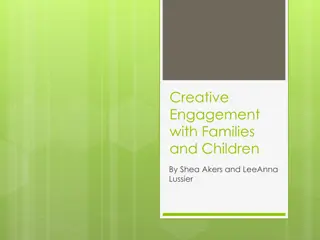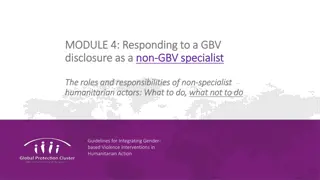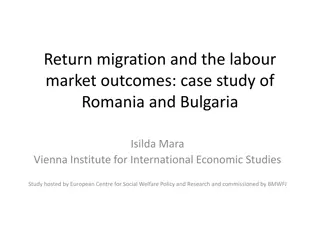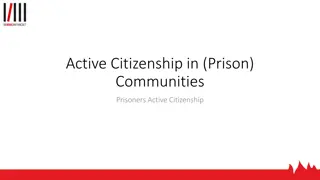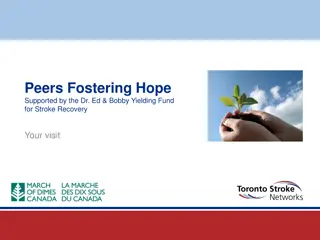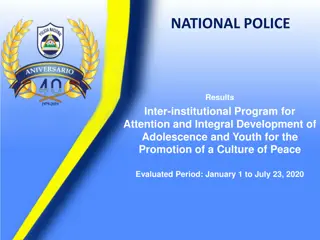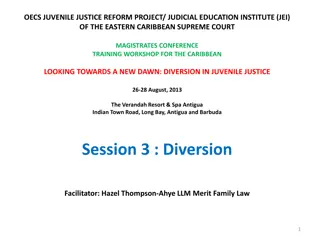Challenges and Opportunities in Women's Reintegration Post-Incarceration
The reintegration of women post-incarceration poses significant challenges and opportunities. With a rising rate of female incarceration, issues such as public safety, economic impact, and precursors to detention need to be addressed. Women offenders face unique obstacles such as histories of mistreatment, mental health issues, and limited job opportunities, impacting their ability to reintegrate successfully. Understanding the characteristics and specific needs of women in the criminal justice system is crucial for effective reintegration efforts and reducing recidivism rates.
Download Presentation

Please find below an Image/Link to download the presentation.
The content on the website is provided AS IS for your information and personal use only. It may not be sold, licensed, or shared on other websites without obtaining consent from the author. Download presentation by click this link. If you encounter any issues during the download, it is possible that the publisher has removed the file from their server.
E N D
Presentation Transcript
The Case of Reintegration of Women Post Incarceration Deana Raley Noble, PhD, MPH, RN November 1, 2015
Relevancy Prison and jail over population major national concern 300 % increase in incarcerations since 1980 (PEW, 2010) Incarceration of women increased at almost double the rate of men since 1980 Rate of incarceration of women far lower than that of men (51 of every 100,000 women vs. 819 of every 100,000 men) (Covington, 2004; Glaze, 2010; LaVigne, Brooks & Shollenberger, 2009) Substantial state and federal government costs to Build, maintain prison, jail facilities; house offenders
Public safety Thousands of inmates released to the community each year with undiagnosed, underdiagnosed, untreated or undertreated communicable diseases, chronic diseases, and mental illness (NCCHC, 2002) Contributes to: Recidivism Homelessness Increased health care costs to the community Increased health risk to the community Spread of infectious disease in the community
Incarceration economic impact Less recidivism among those who get and maintain employment and/or earn a higher wage (LaVigne, Brooks & Shollenberger, 2009; Visher, Debus & Yahner, 2008). Person s income can be reduced by as much as 40% An important factor reducing former inmates employability (Costrel, 2009; LaVigne, Brooks & Shollenberger, 2009; PEW, 2010). Tight job market. Scarce jobs for individuals with a prison record (Costrel, 2009; PEW, 2010; Visher, Debus & Yahner, 2008). Additional obstacles for women to overcome Childcare responsibilities, fewer job skills, higher rates of physical and mental illness that may limit their employability.
Precursors to detention Histories of childhood mistreatment Dysfunctional families Lack of support Substance use/abuse Mental and physical health problems Poverty Homelessness (experienced by >10% with higher rates for women with mental illness) (CSG, NRRC, 2009) Criminal activity (Covington, 2003; Weiss, et al., 2010) Association of victimization, poor mental health and alcohol and drug abuse leading to detention well documented
Characteristics of women offenders Disproportionately women of color Early to mid thirties Family history of detention Survivors of physical and/or sexual abuse Significant substance abuse problems and mental health problems Unmarried mother of minor children High school degree or GED Limited vocational training Sporadic work history, offenses most often drugs or drug related
Re-entry challenges Recidivism rates have remained relatively stable over the years in spite of various programs instituted to reduce recidivism rates (LaVigne, et al., 2009). 45.4 percent of people released from prison in 1999 and 43.3 percent of those sent home in 2004 were re-incarcerated within three years Women released without support in the community are 10 times more likely to be returned to detention in the first 6 weeks of release (Matheson, Doherty & Grant, 2011)
Womens Re-incarceration offenses Most frequent offenses related to Drug and alcohol abuse Physical and mental health problems Homelessness Property offenses Earning money through illegal means (Beck, 2000; Covington, 2003).
Psychological wellbeing and family relationships Relational disconnection has detrimental influence on psychological and emotional wellbeing of women Psychological development of women influenced positively with supportive relational connections and negatively with detrimental relational disconnections More significant for women > fostering development and building relationships with others Connection, not separation, leads to strong, healthy people (Miller & Stiver, 1997) Representation of most women in correction settings Disconnection and violation Dysfunctional family relationships i.e.: child mistreatment
Philosophical foundation Women develop a sense of self and self-worth when their actions come out of and lead back into connections with others. (Covington, 2003; Miller, 1986) Relational-cultural theory applies human growth and social- psychological development to the areas of relational connectedness or disconnectedness with others and the broader community (Miller, 1976) Increasing understanding of the psychological development of gender differences of men and women (Miller, 1976)
Philosophical foundation continued Relational-Cultural theory sees connections as crucial many of women s psychological problems traced to disconnections or breaks among family, personal, or societal relationships (Bylington, 1997) Disconnections and growth hindering life experiences of women may negatively affect their behavior in prison hinder successful reconnection, employment and re-entry into society.
Research purpose This qualitative study undertaken as a step in understanding the phenomenon of reintegration after release from prison. The participant was a formerly incarcerated woman who successfully overcame challenging obstacles to employment, reconnection and re-integration into society. Understanding the elements aiding success in this process was explored as well. Researcher sought to establish a baseline for other researchers to build on in understanding the obstacles and facilitators to reintegration faced by formerly incarcerated women as seen through their eyes and experience Precursors to criminality particular to women and the connective constructs enabling cognitive, psychological and behavioral lifestyle change were explored.
Case study method and research question Focus of the study was to explore a contemporary phenomenon to better understand the case of reintegration into society after release from prison to study the why and how research questions Single case study research method, developed by Yin (2009, 2014), was the research method of study Yin s method is congruent with the sensitizing philosophical framework of Miller s Relational-Cultural theory A single case study best answers the research questions of why and how . The following research questions will be addressed in this study: Why did the participant choose to reintegrate into society? How was the participant able to reintegrate into society successfully?
Single case design study rationale An individual participant with a history of incarceration, and incarceration increases of women, meets the extreme or unusual circumstance rationale Women with a prison record experience enormous reconnection, employment and social reintegration obstacles effecting their future success Single case design presents an opportunity to report in-depth information regarding pathways to criminality and incarceration re-establishing connectedness, employment and social stability post incarceration addition to the body of knowledge surrounding women s re-entry and successful reintegration and relational reconnection post incarceration
Tools Demographic Questionnaire 19 item Participant Interview Guide discussed her experience of factors resulting in incarceration, becoming employed, reconnecting, and reintegrating into society post incarceration 4 in-depth interviews addressed the participant s lived experience pre- incarceration, post-incarceration, and reintegration into community. Interview transcript analysis, enhanced by field notes and observations, revealed environmental and human elements of the interviews. Analysis findings were congruent with current literature Inclusion criteria for the one female participant were that she be 18 years of age or older, have experienced incarceration, post incarceration has gained and maintained employment, reconnection and reintegration into society
Participant demographic profile Self-supporting, recently widowed 52-year old former convict of Irish and Cherokee heritage engaged in completing an undergraduate degree Obtained certification as a California Association of Alcohol and Drug Abuse Counselor (CAADAC II); is a substance abuse counselor for a health insurance company Participant lived with and was source of financial support for her adult daughter and two young grandchildren
Themes revealed Major, minor and sub themes Factors influencing the journey to jail Childhood Adult Substance abuse, health, cycle of incarceration Factors initiating a turning point Hope Faith Factors affecting reentry into community Social acceptance, employment, regaining self confidence, family relationships Factors supporting and maintaining successful reintegration The future
Data analysis Data was analyzed following Yin s case study format. Techniques used to describe and analyze case study evidence included pattern matching and explanation building. Case study data collection results were comparable to and congruent with previous research thereby strengthening the results. The why and how of the study was explained linking causal events of the participant s life experience that led to her incarcerations, life direction change, and successful reentry. Rigor was maintained by following an orderly plan from well thought-out research questions through a comprehensive literature review, adhering to ethical research procedures, protecting validity, exploring and examining alternate explanations, and preserving the chain of evidence. Attention was given to matching the case study s operational measures to the concepts being studied by using multiple sources of evidence, establishing a chain of evidence, and having the participant review the draft interview manuscript (chapter 4) for accuracy. This case study research was compatible with Miller s (1986) Relational-Cultural theory and principles of relational connection and disconnection. The design of the case study was such that the research steps can be followed by a future researcher as detailed in chapter three.
Qualitative research Participation in qualitative research inevitably involves interaction with the participant and may be construed as bias, an element that would be difficult to eliminate. Insight into the participant s life experience of incarceration and reentry was achieved through direct communication and observation of emotional responses. The participant responded positively to meeting with the researcher and to the opportunity of contributing to research by sharing her story. Case study methodology lends itself to discovering the stories of women ex-offenders of different backgrounds, ethnicities, cultures and environments. There is scant information in this area of research that could unquestionably benefit from further research.
Critique of the study The researcher kept careful notes of observations, emotions, responses and related thoughts as the interviews were conducted. Careful, extensive data reviewing led to the development of four major themes, nine minor themes and three sub themes. The opportunity to spend an extended period of time with the participant as she recounted her life experience during the four interview sessions added to the richness of the findings. The results of a single case study focusing on one participant s successful reentry into society has limited generalizability to another location or reentry population. Continuation of data collection to the point of saturation helped address this issue. The participant was of Irish and American Indian ancestry and appeared to be and classified herself as Caucasian. Her life experiences as related in the study had commonalities with but was not necessarily representative of other racial or ethnic ex-offenders life experiences.
Synopsis of interview data: journey to jail Childhood Childhood maltreatment, family dysfunction, lack of support and oversight, substance use and abuse, mental and physical health problems, and criminal activity were a part of her experience and mirrored precursors to incarceration Started smoking at age 12, started using (alcohol, cocaine and marijuana) at age 14. Revealed a multi-generation history of alcoholism on both sides of family
Interview data: journey to jail Adult 20 y.o. when daughter was born admitted smoking, using drugs, and drinking during her entire pregnancy and after her daughter s birth addictive behaviors contributed to a chaotic lifestyle family pattern of child neglect and dysfunction continued daughter lived with maternal grandmother or aunt for most of childhood with periodic contact with participant
Interview data: journey to jail Substance abuse childhood experiences of neglect and household dysfunction influenced participant s alcohol and drug use and all the decisions that I made, and not in a good way. reported becoming addicted the first time methamphetamines (meth) tried, which then became drug of choice for the next 15 to 20 years: recalled aspects of the meth culture revolving primarily around getting, selling, having, manufacturing drugs, staying under the influence ( it s usually just really about staying loaded ), [I] would not have considered stopping doing what I was doing because I hadn t hit the bottom. arrested and detained several times for possession of, manufacturing, and/or selling methamphetamines When released from confinement, participant always went to mother s home; mother was chief enabler as drinking alcohol was allowed
Interview data: journey to jail Health Culture and environment around a lifestyle of substance abuse has negative health consequences health problems experienced were viral meningitis gall bladder attacks urinary tract infections dental problems hip injury resulting from car accident as teenager mental health problems such as depression, anxiety, and paranoia and although undiagnosed, participant believed she had an attention deficit disorder.
Interview data: journey to jail Cycle of incarceration twenty-five year pattern of active drug use, arrests, and incarceration: I did twelve years total, off and on, on the installment plan, in prison to prisons and jails. And that doesn t really count all the times in county jail. or on probation a lifestyle of substance abuse, criminal activity, and incarcerations estranged her from significant family members, daughter especially began to gain awareness of the lifestyle harm when realized the impact the drug use might have on daughter path toward sober living and relationship reconnection began when association between substance use and arrests was finally made
Interview data: turning point Hope had feelings of hopelessness, shame and the things I had thrown away or had just disintegrated over the years. I describe it as a nuclear bomb blast. Nothin s living. had been ashamed for so very long . to cope with shame would get loaded. Really quick. Not gonna feel that feeling . there were hopeful times as well, pain and hopeful . for former inmates, hope has the potential to enable them to move forward. participant was hopeful to be reunited with daughter. desire to reconnect with daughter became strong incentive and part of confluence of events preceding and spurring the decision to get sober
Interview data: turning point Faith relates one of those light bulb moments realized she was a drug addict. cellmate showed her Psalms 107: 13-14 to read. The words about breaking away the chains got her attention, she said she, grabbed a Bible and I took it in my room . described a clear conversion experience : [It was] a hallelujah moment when everything became clear in my drug-addled brain [it was] like bubbles like the best high, only without [drugs] it s clarity, it s like peace, it s like joy, all those things you come to an understanding that your way doesn t work and that God can and will remove the obsession of drinking and using . Mental clarity was coming back , was choosing a different life style, Bible reading, attending church meetings held in the prison, asking questions, becoming involved with different people and sharing her spiritual awakening with other addicts.
Interview data: Reentry Into the Community Social acceptance significant connection with Christian peer recovery support service for women as she transitioned from prison into the broader community and later, into employment and service credited the women in this organization for encouraging and motivating continued spiritual growth, providing moral support for the reconnection and reintegration challenges facing her. Barriers faced mirrored most of those identified in the literature: staying sober, adjusting to sober living housing requirements, reconnecting and adjusting to family getting a job, acquiring transportation addressing physical and mental health problems, lack of trust, lack of health insurance dealing with stigma of incarceration, including low self-worth, guilt, shame, and rejection.
Interview data: reentry into community Employment had worked off and on in various jobs, in and out of prison obtained employment after last release because they didn t ask the felony question on the application, so I was able to get that job. worked for a Christian women s peer recovery service organization where being an ex- offender was a required condition for employment. obtained a job on campus when attended community college where they all knew I was in recovery, they knew I was an ex-offender, they knew all about me, and I think that s the reason why they hired me. as education advanced, obtained certification to work with and educate substance users/abusers and became employed in this arena. employment did not turn out to be difficult for participant, participant knew her case was an exception rather than the rule. counseled other ex-offenders felonies are gonna be a barrier to employment So [I would tell others] where maybe you used to apply for one or two jobs, you might have to apply for fifty now. But you re gonna get hired. participant recommended ex-offenders consider education first to put time between yourself and your conviction and you re gonna put some experience between yourself and your conviction[s]..
Interview data: reentry into community Regaining self confidence Significant barriers were removed or modified to her benefit that she interpreted to be answers to prayer. was accepted into the drug addict CRC program, had a life-changing spiritual experience, stayed sober, was accepted into a sober living facility after release, received financial aid to attend community college, began to reconnect with her daughter and mother, and got married. continued to face difficulties because of her criminal history because you are not looked at as the same as other people, worked to regain loved ones trust, cope with less than minimal income, manage illness, resolve workplace conflicts and be supportive of a husband who was also an addict and had relapsed and gone to jail credited these differences, compared with previous releases, to the fact that, I had time to breathe, I had time to grow, I had a safe place to stay, and not having to barter my life, my liberty by selling drugs in order to have this, a place to stay. I chose to do everything different. And that s how the barriers get broken down. I m doing what I m doing, and I m loving what I m doing, I m loving my school, I m loving my job, I m loving being in service in, you know, every aspect of my life.
Interview data: reentry into community Family relationships CRC program required she go directly into a sober living facility on release but no sober living beds were immediately available had to go to her mother s house first; was diligent to stay sober and meet parole requirements. was accepted into a sober living and treatment program a week after her release from prison. attributed her new life changes to the Holy Spirit...with new creation sort of bubbling out of me. relationships with daughter and mother were improving had rough patches with daughter as they worked through relationship difficulties, participant recognized this as some obvious dysfunction [because] I didn t know how to be a parent.
Interview data: reentry into community Family relationships met her husband at the sober living facility. Described their relationship as a key component to reintegration worked to overcome challenges to reentry together, supporting and encouraging one another. They found when you re putting God first, your recovery first all the rest just seemed kind of to fall into place. shared, we met at the perfect time. We were both early in recovery and both of us heading in that healthy direction. And we loved each other well for 15 years. sister refused to reconcile, told her, I will never forgive you. participant accepted the rejection, let sister know how much she appreciated everything she had done for her daughter. AA s philosophy of making amends and their version of the Serenity Prayer in this instance referring to the phrase God grant us the serenity to accept the things we cannot change. helped her accept her sister s rejection, while hoping one day she would change her mind, were shared, I absolutely would not have, could not have continued with that process of change but for that spiritual light bulb moment that I had.
Interview data: supporting and maintaining reintegration The future participant s life and vision of the future had roots in her spiritual awakening while in prison. credited following each step of the twelve-step program. began to apply this principle before she was released, believing in the aim of the twelfth step to carry the message to the addict[s] who still suffer. overcoming barriers and achieving goals is an incremental process a program of rigorous honesty a daily process. The tools of recovery aided her life change and successful reintegration. The tools are action steps to maintain sobriety fellowshipping, reading, praying, contacting, not isolating service to other human beings recovery is action, faith is action.
Discussion of findings This study was undertaken to understand the experience of women who have surmounted the challenges and successfully reintegrated into society post incarceration and in order to understand the life experiences of a marginalized portion of our society Case study methodology developed by Yin (2009, 2014) was utilized in this in- depth, single case design and represents a unique case. The overall purpose of this descriptive and explanatory research was to explore precursors to criminality particular to women explore connective constructs enabling cognitive, psychological and behavioral lifestyle change.
Ethical issues The Committee on the Protection of Human Subjects of the University of San Diego approved this study prior to its institution. Protecting the participant s rights and welfare was a priority and judicious ethical practices were established for the study. The participant was invited by telephone contact to participate in the study. Prior to the initial interview, written consent was obtained from the participant and she was advised that the risk to her was no greater than those encountered in everyday life. The participant was informed she could stop and rest, reschedule the session, or withdraw from the study at any time if she wished to do so. Additionally, the participant was informed that all questions about the study would be addressed, and that a copy of the findings would be made available to her if desired. Confidentiality has been rigorously maintained. Participants name has been kept separate from the audiotapes of the interviews and from the transcripts for those interviews. Pseudonyms were used in the narrative. Computer data files, USB drives, and hard copy transcripts have been kept secure. All research data will be destroyed within five years of the completion of this study. While no direct benefits were expected from participation in this study, potential benefits as a participant in a research project may be increased self-esteem and empowerment and of contributing to a greater awareness and insight into women s reentry challenges. Another possible benefit is gratification in sharing her story with an attentive listener and researcher who was a registered nurse she knew and who had some knowledge of and had worked with women in the jail and in recovery in the community.
Reflections on the study Listening to, appreciating and learning from the participant s story provided insight into the powerful addictiveness and consequences of methamphetamine use and of the drug culture as well as a perspective of the criminal justice system and life in detention. The confluence of events and awareness motivating the participant s decision to stop using drugs, comply with parole restrictions, and change her lifestyle on release was enabled by her dramatic and inspiring faith conversion. On reentry, subsequent spiritual development, sober living, treatment adherence, academic achievements, employment acquisition, housing and financial stability, confidence and self-esteem empowerment, relationship reconnections, and giving back opportunities afforded motivation, meaning, and purpose in the maintenance of the lifestyle change. During the interview sessions some aspects of the participant s physical, emotional and mental responses were observed by the investigator. During the first interview it was apparent both from our conversation and her demeanor that she was somewhat despondent. She shared grieving the loss of her husband. That his death was a profound loss was apparent throughout all the interview sessions. Her love for and attachment to her daughter and grandchildren was also apparent and sustaining for her as was her substance abuse education job and her mentoring work shepherding newly released women on their return to the community.
Insights In the interviews, as she told her story, strong emotions were elicited on occasion as experiences were recalled and even, it seemed, momentarily re-lived. Changes in her language, which, in general, she chose to sanitize for the listener, would on occasion burst forth into the idioms and patterns from the past that might elicit an apology and/or a modification to more conventional language. Emotional responses were most pronounced with recollections of her neglect of her daughter, drug culture activities, interactions with her mother, her spiritual awakening, meeting her husband, loss of both husband and mother, and conflict in the work place. Major events such as a death in the family and the pain of that loss often trigger recovering addicts into reverting to drugs to numb the pain and feelings of loss. To resist this pull, the participant, each day, turned to her faith tools to maintain her recovery. The researcher was reminded that, for this population, maintaining and sustaining recovery is not a once and for all occurrence but a daily commitment to sobriety.
Community concerns An area of her life touched on by the participant, one on which she choose not to elaborate, was that of sexuality in the drug culture. Methamphetamines alter judgment and reduce inhibitions, people who engage in unsafe sex risk contracting sexually transmitted infectious diseases (National Institute on Drug Abuse (NIAD), 2014). This is an area of public health concern in correction facilities and in the community. Undiagnosed, underdiagnosed, untreated or undertreated communicable diseases, chronic diseases, and mental illness in many of the released population contribute to Spread of infectious disease in the community Homelessness Increased health care costs to the community Increased health risk to the community Recidivism (NCCHC, 2002)
Directions for Future Research Further qualitative research on successful reintegration of women ex-offenders is warranted. Further qualitative research of real life stories of women prisoners of different races, ethnicities, cultures and environments would add an important research element to understanding this marginalized population. Future research on prisoner pre-release education and preparation programs with above average reentry success is merited. Research into community preparedness for newly reclassified and released detainees is vital for facilitating sustainable reentry and addressing community concerns.
